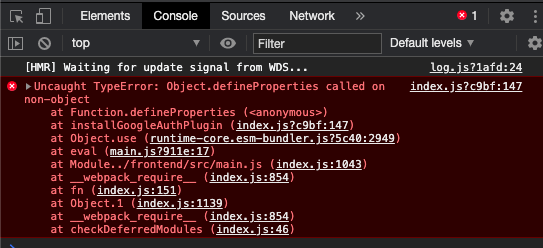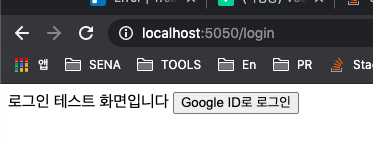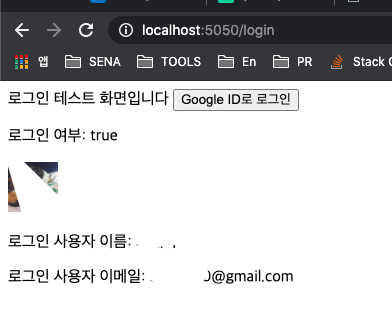비록 express 로 서버를 만들고는 있지만 가능한 간편하게 하기 위해서 frontend 선에서 인증 기능을 구현하기로 했다.
더불어 내가 인증 기능을 만들긴 싫어서 Google OAuth를 쓰기로 한다.
오늘의 목표 📋
☑️ Vue3에 Google OAuth2.0 붙이기
☑️ 로그인 후 사용자 정보 받아오기
☑️ 로그아웃 구현하기
Google API에 내 사이트 등록 하기
사전에 Google API에 들어가서 신규 프로젝트 생성 후 토큰과 비밀키를 발급받아야 한다.
이 부분은 친절한 블로그에 잘 정리가 되어있으니 따라하자.
마지막에 발급 받은 클라이언트 ID와 비밀키는 .env 파일을 만들어서 저장한다.
Vue는 dotenv를 설치하지 않아도 자동으로 .env 파일을 읽어들인다.
단! 환경변수 이름이 무조건 VUE_APP_ 으로 시작해야 한다.
프로젝트 루트 경로에 .env파일을 만들고 클라이언트 키를 저장해두자.
VUE_APP_OAUTH_CLIENT=비밀이지롱내 프론트엔드에 OAuth 붙이기
진짜 감사하게도 유명한 라이브러리가 있다
https://www.npmjs.com/package/vue-google-oauth2
Vue, google oauth 등으로 검색하면 99%는 위 모듈을 가져다 쓰는 샘플이다.
검색하면 샘플도 적잖이 있어서 맘편하게 가져다 쓰기로.
npm install vue-google-oauth2패키지를 설치해준 다음 frontend/src/main.js 파일을 열어 사용 설정을 해준다.
import GAuth from 'vue-google-oauth2'
app.use(GAuth, {
clientId: process.env.VUE_APP_OAUTH_CLIENT, // 아까 .env 파일에 저장해둔 그것임
scope: 'profile email https://www.googleapis.com/auth/plus.login'
});로그인 페이지 만들기
다음은 테스트용 로그인 페이지이다.
frontend/src/views/Login.vue파일을 열어서 테스트 코드를 써주었다.
<template>
<div>
로그인 테스트 화면입니다
<button
@click="handleLogin"
>
Google ID로 로그인
</button>
</div>
</template>
<script>
export default {
name: 'Login',
data: () => ({
}),
methods: {
async handleLogin() {
try {
const GoogleUser = await this.$gAuth.signIn();
console.log(GoogleUser);
} catch (e) {
console.error(e);
}
},
},
};
</script>그런 다음 화면을 띄워보면?

☠️ 에러가 난다.
시키는 대로 했는데 왜...!

소스를 까봤더니 아니나 다를까 😊 Vue3로 업그레이드 한 것이 문제가 된 것이다.
Vue3에서 전역모듈을 삽입하는 방법이 바뀐 덕분에 제대로 코드가 돌아가지 않고 있었다.
이제와서 다운그레이드 할 생각은 없고 vue-google-oauth2 코드를 참조해서 새로 모듈을 작성하기로 했다.
다시 시도 하기🔥
쓰지 못하는 모듈의 전체 소스가 길지 않아 카피해왔다.
npm uninstall vue-google-oauth2기존 것은 지워주고
frontend/src/authentification.js 파일을 만들어서
기존 vue-google-oauth2의 코드를 복사해온 다음 Vue3에 맞게 변형한다.
var googleAuth = (function () {
function installClient() {
var apiUrl = 'https://apis.google.com/js/api.js'
return new Promise((resolve) => {
var script = document.createElement('script')
script.src = apiUrl
script.onreadystatechange = script.onload = function () {
if (!script.readyState || /loaded|complete/.test(script.readyState)) {
setTimeout(function () {
resolve()
}, 500)
}
}
document.getElementsByTagName('head')[0].appendChild(script)
})
}
function initClient(config) {
return new Promise((resolve, reject) => {
window.gapi.load('auth2', () => {
window.gapi.auth2.init(config)
.then(() => {
resolve(window.gapi)
}).catch((error) => {
reject(error)
})
})
})
}
function Auth() {
if (!(this instanceof Auth))
return new Auth()
this.GoogleAuth = null /* window.gapi.auth2.getAuthInstance() */
this.isAuthorized = false
this.isInit = false
this.prompt = null
this.isLoaded = function () {
/* eslint-disable */
console.warn('isLoaded() will be deprecated. You can use "this.$gAuth.isInit"')
return !!this.GoogleAuth
};
this.load = (config, prompt) => {
installClient()
.then(() => {
return initClient(config)
})
.then((gapi) => {
this.GoogleAuth = gapi.auth2.getAuthInstance()
this.isInit = true
this.prompt = prompt
this.isAuthorized = this.GoogleAuth.isSignedIn.get()
}).catch((error) => {
console.error(error)
})
};
this.signIn = (successCallback, errorCallback) => {
return new Promise((resolve, reject) => {
if (!this.GoogleAuth) {
if (typeof errorCallback === 'function') errorCallback(false)
reject(false)
return
}
this.GoogleAuth.signIn()
.then(googleUser => {
if (typeof successCallback === 'function') successCallback(googleUser)
this.isAuthorized = this.GoogleAuth.isSignedIn.get()
resolve(googleUser)
})
.catch(error => {
if (typeof errorCallback === 'function') errorCallback(error)
reject(error)
})
})
};
this.getAuthCode = (successCallback, errorCallback) => {
return new Promise((resolve, reject) => {
if (!this.GoogleAuth) {
if (typeof errorCallback === 'function') errorCallback(false)
reject(false)
return
}
this.GoogleAuth.grantOfflineAccess({ prompt: this.prompt })
.then(function (resp) {
if (typeof successCallback === 'function') successCallback(resp.code)
resolve(resp.code)
})
.catch(function (error) {
if (typeof errorCallback === 'function') errorCallback(error)
reject(error)
})
})
};
this.signOut = (successCallback, errorCallback) => {
return new Promise((resolve, reject) => {
if (!this.GoogleAuth) {
if (typeof errorCallback === 'function') errorCallback(false)
reject(false)
return
}
this.GoogleAuth.signOut()
.then(() => {
if (typeof successCallback === 'function') successCallback()
this.isAuthorized = false
resolve(true)
})
.catch(error => {
if (typeof errorCallback === 'function') errorCallback(error)
reject(error)
})
})
};
}
return new Auth()
})();
export default googleAuth;Vue에 설치하는 부분을 제거했을 뿐이다.
그 다음 frontend/src/main.js 를 재수정한다.
이전 코드는 전부 지워버려라. 💧
// import GAuth from 'vue-google-oauth2'; // 아래 모듈로 대체된다
import googleAuth from './authentification';
import App from './App.vue'
// Create Vue Instance
const app = createApp(App);
...
app.use(GAuth, {
clientId: process.env.VUE_APP_OAUTH_CLIENT,
scope: 'profile email https://www.googleapis.com/auth/plus.login'
});
// set auth config
const prompt = 'select_account'
const GoogleAuthConfig = Object.assign({ scope: 'profile email' }, {
clientId: process.env.VUE_APP_OAUTH_CLIENT,
scope: 'profile email https://www.googleapis.com/auth/plus.login',
});
// Install Vue plugin
app.config.globalProperties.$gAuth = googleAuth;
app.config.globalProperties.$gAuth.load(GoogleAuthConfig, prompt)
// ... 생략이건 나중에 기존 프로젝트 포크따서 올려둬야겠다.
Vue3 공식 홈페이지를 참조해서 후에 this.$gAuth를 사용할 수 있게 전역 모듈을 등록한 것이다.
여기까지 해주었다면 로그인 페이지를 다시 열어보자.

에러없이 화면이 잘 떴다. 🌟
Google ID로 로그인 버튼을 누르면 새로운 팝업에 구글 로그인 화면이 뜨고 로그인 할 수 있다!
사용자 정보 받아오기
로그인을 했으면 했다고 떴으면 좋겠다.
화면을 조금 변경해보자.
frontend/src/views/Login.vue
<template>
...
<button
:disabled="signedIn"
@click="handleLogin"
>
Google ID로 로그인
</button>
<div>
<p> 로그인 여부: {{signedIn}}</p>
<img :src="userImage" width="50" height="50"/>
<p> 로그인 사용자 이름: {{ userName }} </p>
<p> 로그인 사용자 이메일: {{ userEmail }} </p>
</div>
...
</template>
<script>
export default {
name: 'Login',
data: () => ({
signedIn: false,
userName: null,
userEmail: null,
userImage: null,
}),
methods: {
clear() {
this.signedIn = null;
this.userName = null;
this.userImage = null;
this.userEmail = null;
},
async handleLogin() {
try {
const GoogleUser = await this.$gAuth.signIn();
if (!GoogleUser.isSignedIn()) throw new Error('로그인에 실패했습니다.');
this.signedIn = GoogleUser.isSignedIn();
this.userName = GoogleUser.getBasicProfile().getName();
this.userImage = GoogleUser.getBasicProfile().getImageUrl();
this.userEmail = GoogleUser.getBasicProfile().getEmail();
} catch (e) {
console.error(e);
}
},
},
};
</script>GoogleUser에서 받아올 수 있는 정보는 공식 홈페이지를 보고 따왔다.
다시 로그인 페이지로 돌아가서 로그인을 해보자.

짠! 구글에서 받아온 프로필 이미지, 이름, 이메일 주소 등이 정상적으로 출력된다.
초간단 로그아웃
frontend/src/views/Login.vue
로그아웃 버튼과 로그아웃 함수, 정보 클리어 함수를 구현한다.
...
<button
:disabled="!token"
@click="handleLogout"
>
로그아웃
</button>
...
methods: {
clear() {
this.signedIn = null;
this.userName = null;
this.userImage = null;
this.userEmail = null;
},
...
async handleLogout() {
try {
await this.$gAuth.signOut();
this.clear();
} catch (e) {
console.error(e);
} finally {
this.$router.push('/');
}
}로그아웃 버튼을 눌러 동작을 확인한다.
안될리가 없지 😏 잘 된다.
다만 여기까지 했을 때의 문제점은 이 화면에 들어올 때 마다 로그인을 다시 해야 한다 는 것이다.
그러니 토큰 매니저를 만들어서 브라우저의 쿠키를 사용하자.
.. 는 내일하자.
끝


이까지 하고 보니 vue-google-oauth2 개발자분이 vue3를 위해 새로운 버전을 릴리즈 하셨던걸 뒤늦게 발견했다 ^^ 후... 서치좀 잘하자 나자신....
저처럼 고생하지 마세요 => https://github.com/guruahn/vue3-google-oauth2